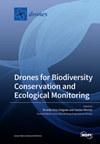Relative Localization within a Quadcopter Unmanned Aerial Vehicle Swarm Based on Airborne Monocular Vision
IF 4.4
2区 地球科学
Q1 REMOTE SENSING
引用次数: 0
Abstract
Swarming is one of the important trends in the development of small multi-rotor UAVs. The stable operation of UAV swarms and air-to-ground cooperative operations depend on precise relative position information within the swarm. Existing relative localization solutions mainly rely on passively received external information or expensive and complex sensors, which are not applicable to the application scenarios of small-rotor UAV swarms. Therefore, we develop a relative localization solution based on airborne monocular sensing data to directly realize real-time relative localization among UAVs. First, we apply the lightweight YOLOv8-pose target detection algorithm to realize the real-time detection of quadcopter UAVs and their rotor motors. Then, to improve the computational efficiency, we make full use of the geometric properties of UAVs to derive a more adaptable algorithm for solving the P3P problem. In order to solve the multi-solution problem when less than four motors are detected, we analytically propose a positive solution determination scheme based on reasonable attitude information. We also introduce the maximum weight of the motor-detection confidence into the calculation of relative localization position to further improve the accuracy. Finally, we conducted simulations and practical experiments on an experimental UAV. The experimental results verify the feasibility of the proposed scheme, in which the performance of the core algorithm is significantly improved over the classical algorithm. Our research provides viable solutions to free UAV swarms from external information dependence, apply them to complex environments, improve autonomous collaboration, and reduce costs.基于机载单目视觉的四轴飞行器群相对定位
蜂群是小型多旋翼无人机发展的重要趋势之一。无人机群的稳定运行和空对地协同作战依赖于群内精确的相对位置信息。现有的相对定位方案主要依赖于被动接收的外部信息或昂贵复杂的传感器,不适合小旋翼无人机群的应用场景。因此,我们开发了一种基于机载单目传感数据的相对定位方案,直接实现无人机之间的实时相对定位。首先,采用轻量级的yolov8姿态目标检测算法,实现对四旋翼无人机及其转子电机的实时检测。然后,为了提高计算效率,充分利用无人机的几何特性,推导出一种适应性更强的求解P3P问题的算法。为了解决电机检测不足4台时的多解问题,分析提出了一种基于合理姿态信息的正解确定方案。在相对定位位置的计算中引入电机检测置信度的最大权重,进一步提高了相对定位位置的精度。最后,在一架实验无人机上进行了仿真和实际实验。实验结果验证了所提方案的可行性,与经典算法相比,核心算法的性能得到了显著提高。我们的研究提供了可行的解决方案,使无人机群摆脱对外部信息的依赖,将其应用于复杂环境,提高自主协作能力,降低成本。
本文章由计算机程序翻译,如有差异,请以英文原文为准。
求助全文
约1分钟内获得全文
求助全文

 求助内容:
求助内容: 应助结果提醒方式:
应助结果提醒方式:


